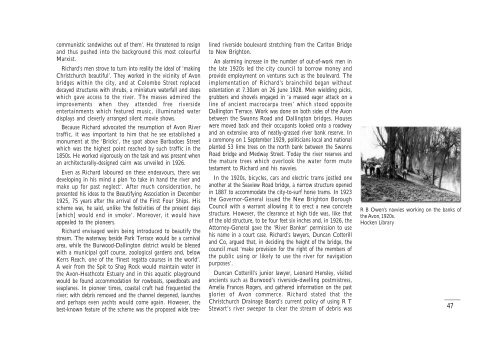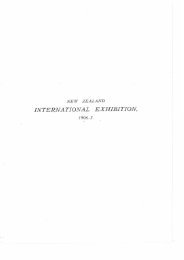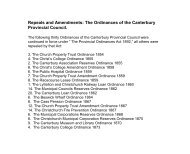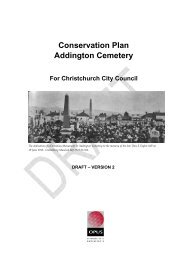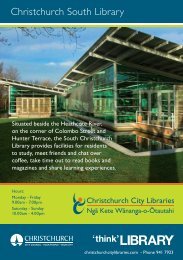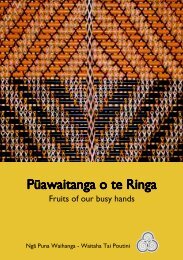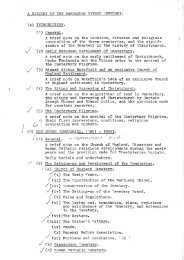Rich man, poor man, environmentalist, thief - Christchurch City ...
Rich man, poor man, environmentalist, thief - Christchurch City ...
Rich man, poor man, environmentalist, thief - Christchurch City ...
Create successful ePaper yourself
Turn your PDF publications into a flip-book with our unique Google optimized e-Paper software.
communistic sandwiches out of them’. He threatened to resign<br />
and thus pushed into the background this most colourful<br />
Marxist.<br />
<strong>Rich</strong>ard’s men strove to turn into reality the ideal of ‘making<br />
<strong>Christchurch</strong> beautiful’. They worked in the vicinity of Avon<br />
bridges within the city, and at Colombo Street replaced<br />
decayed structures with shrubs, a miniature waterfall and steps<br />
which gave access to the river. The masses admired the<br />
improvements when they attended free riverside<br />
entertainments which featured music, illuminated water<br />
displays and cleverly arranged silent movie shows.<br />
Because <strong>Rich</strong>ard advocated the resumption of Avon River<br />
traffic, it was important to him that he see established a<br />
monument at the ‘Bricks’, the spot above Barbadoes Street<br />
which was the highest point reached by such traffic in the<br />
1850s. He worked vigorously on the task and was present when<br />
an architecturally-designed cairn was unveiled in 1926.<br />
Even as <strong>Rich</strong>ard laboured on these endeavours, there was<br />
developing in his mind a plan ‘to take in hand the river and<br />
make up for past neglect’. After much consideration, he<br />
presented his ideas to the Beautifying Association in December<br />
1925, 75 years after the arrival of the First Four Ships. His<br />
scheme was, he said, unlike ‘the festivities of the present days<br />
[which] would end in smoke’. Moreover, it would have<br />
appealed to the pioneers.<br />
<strong>Rich</strong>ard envisaged weirs being introduced to beautify the<br />
stream. The waterway beside Park Terrace would be a carnival<br />
area, while the Burwood-Dallington district would be blessed<br />
with a municipal golf course, zoological gardens and, below<br />
Kerrs Reach, one of the ‘finest regatta courses in the world’.<br />
A weir from the Spit to Shag Rock would maintain water in<br />
the Avon-Heathcote Estuary and in this aquatic playground<br />
would be found accommodation for rowboats, speedboats and<br />
seaplanes. In pioneer times, coastal craft had frequented the<br />
river; with debris removed and the channel deepened, launches<br />
and perhaps even yachts would come again. However, the<br />
best-known feature of the scheme was the proposed wide tree-<br />
lined riverside boulevard stretching from the Carlton Bridge<br />
to New Brighton.<br />
An alarming increase in the number of out-of-work men in<br />
the late 1920s led the city council to borrow money and<br />
provide employment on ventures such as the boulevard. The<br />
implementation of <strong>Rich</strong>ard’s brainchild began without<br />
ostentation at 7.30am on 26 June 1928. Men wielding picks,<br />
grubbers and shovels engaged in ‘a massed eager attack on a<br />
line of ancient macrocarpa trees’ which stood opposite<br />
Dallington Terrace. Work was done on both sides of the Avon<br />
between the Swanns Road and Dallington bridges. Houses<br />
were moved back and their occupants looked onto a roadway<br />
and an extensive area of neatly-grassed river bank reserve. In<br />
a ceremony on 1 September 1929, politicians local and national<br />
planted 53 lime trees on the north bank between the Swanns<br />
Road bridge and Medway Street. Today the river reserves and<br />
the mature trees which overlook the water form mute<br />
testament to <strong>Rich</strong>ard and his navvies.<br />
In the 1920s, bicycles, cars and electric trams jostled one<br />
another at the Seaview Road bridge, a narrow structure opened<br />
in 1887 to accommodate the city-to-surf horse trams. In 1923<br />
the Governor-General issued the New Brighton Borough<br />
Council with a warrant allowing it to erect a new concrete<br />
structure. However, the clearance at high tide was, like that<br />
of the old structure, to be four feet six inches and, in 1926, the<br />
Attorney-General gave the ‘River Banker’ permission to use<br />
his name in a court case. <strong>Rich</strong>ard’s lawyers, Duncan Cotterill<br />
and Co, argued that, in deciding the height of the bridge, the<br />
council must ‘make provision for the right of the members of<br />
the public using or likely to use the river for navigation<br />
purposes’.<br />
Duncan Cotterill’s junior lawyer, Leonard Hensley, visited<br />
ancients such as Burwood’s riverside-dwelling postmistress,<br />
Amelia Frances Rogers, and gathered information on the past<br />
glories of Avon commerce. <strong>Rich</strong>ard stated that the<br />
<strong>Christchurch</strong> Drainage Board’s current policy of using R T<br />
Stewart’s river sweeper to clear the stream of debris was<br />
R B Owen’s navvies working on the banks of<br />
the Avon, 1920s.<br />
Hocken Library<br />
47


